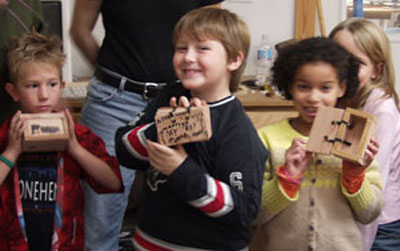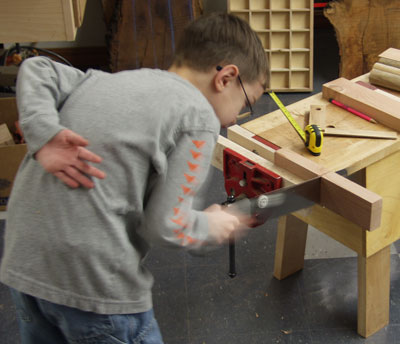Woodworking for Kids
A seasoned woodworker and teacher explains the importance of setting up woodworking programs in schools
When I was in college, an older friend who helped me restore an antique Ford observed, “I don’t know why you’re studying to be a lawyer. Your brains are in your hands.” That simple observation led me to re-evaluate my plans and eventually become a woodworker.
My daughter Lucy began regular visits to my wood shop when she was three. If you have children of your own, you understand the very important feelings that arise when you introduce your child to something that you love so much. I have enough love of woodworking to feel a need and a responsibility. I feel it’s important to share what we love and what we know with new generations to provide a foundation for the growth and development of new generations.
It was the time spent with my daughter in the woodshop that helped me to envision Wisdom of the Hands, the woodworking program I developed for the Clear Spring School, a small independent school in Northwest Arkansas. Wisdom of the Hands recognizes the importance of integrating the head and hands in the development of intelligence for all students.

Even the youngest students can take pride in the work they create in a well-run school woodshop program.
Hands-on benefits
Hands-on education is nothing new. It has been advocated by theorists for centuries, from Comenius and Jean Jacques Rousseau, to Pestalozzi and Froebel, then to John Dewey and Howard Gardner. It was Rousseau who said, “Put a young man in a workshop, his hands will work to the benefit of his brain, and he will become a philosopher while thinking himself only a craftsman.”
Through Wisdom of the Hands, I’ve discovered huge benefits for the children. Woodworking has become a favorite activity throughout the school. The counting, measuring, and problem-solving that goes on in the woodshop helps the kids in all their other classes. I describe this experience in a regular blog. You’re welcome to visit and follow my discourse on the significance of hands on learning, but you may not need it. We woodworkers seem to grasp the relationship between the hands and learning. We don’t need experts to tell us what we know so clearly from our own experience.
However, it seems unlikely that there will be a renewal of woodworking in schools any time soon. The decline of woodshop courses began long ago, when the so-called Russian system was widely promoted to supply the demand for a largely unskilled workforce. But as the U.S. economy moved away from an unskilled manufacturing base, school woodshops became the dumping ground for unsuccessful students. Stripped of their original mission, woodshops have foundered.
But by reexamining the origins of woodshop, we gain a renewed sense of possibility. At Clear Spring School, we hope the Wisdom of the Hands program provides an example for other schools to follow, but if you want your child or grandchild to have the creative opportunities and growth that woodworking offers, you will need to take matters in your own hands.
Setting up a school program
There are many ways to start. You can buy woodworking project kits for your kids to assemble. If you don’t have time to dream up more interesting and engaging projects, kits can be a fun activity to share. But they pale in comparison to the educational benefit that comes through more experimental woodworking: when there are good old-fashioned mistakes to be made, opportunities for your child to help design things engage in problem solving. For that you will need to go a little deeper in your preparations.
In late 2001, I learned about an early system of woodworking training called Educational Sloyd. It originated in Finland and Sweden and was introduced throughout the world in the latter part of the 19th century. Sloyd, now nearly forgotten, was a very important part of our own manual training history, replaced by the Russian system. (In a nutshell, Sloyd advocated hands-on education for everyone, while the Russian system pushed some students into industry to create an unskilled work force.) My study of Educational Sloyd led my expansion of the woodworking program at Clear Spring School into the primary grades.
|
Five Rules for Setting Up a School Woodshop Program These rules from the theory of Educational Sloyd can help any adult in guiding the development of young hands and minds in the wood shop. 1. Move gradually from the known to the unknown, from the easy to the more difficult, from the concrete to the abstract. 2. Create lessons to involve the senses, particularly touch, sight, and smell. 3. Design activities to reinforce the connections between the child, the family, the school and the community. 4. Plan your projects so that tools can be introduced one or two at a time. It is important that kids aren’t overloaded with information all at once and that they can spend enough time with each tool to develop an understanding of its uses and limitations. Plan simple projects at first. Complications can come later. You may be surprised that children have very little understanding of or experience with handwork. Even folding paper and cutting with scissors are largely forgotten in our computer age. 5. Have fun. You will be providing memories for a lifetime that may have impact for generations. |
Keeping kids safe
Children, even teens in high school, have little sense of cause and effect relationships. It is worse these days because of the amount of time kids spend watching TV or playing computer games. Working with sharp tools presents a danger. Trying to woodwork with dull tools presents an even greater danger. To make certain that children’s experience in the woodshop is a positive one for them and for me, I have a few rules that arise from basic common sense.
One, no woodworking without adult supervision. This rule applies to all ages, preschool through high school. My job as an adult is to create a safe learning opportunity, so this rule is very important.

Learning how to hammer safely under a grownup’s watchful eye.
Two, use clamps or a bench vise to hold work for cutting, sanding, or drilling. Most injuries happen to the non-dominant hand. Injuries from tools that slip can be totally avoided by the use of vises or clamps to hold the stock. At Clear Spring School we made our own somewhat portable workbenches (click for a drawing) that adjust to different heights for use by our youngest students. A good clamping method is a must for safe woodworking. An arrangement of clamps can fill in as a temporary solution, but young hands won’t have the strength required to clamp tightly. You will need to help.

Easy-to-build, kid-sized benches. On the bench at right is a “sock,” or leg extender, that elevates the bench. (click for a drawing)
When kids use a handsaw, either both hands grasp the tool or one goes behind the back. Sometimes a child may have to use his or her non-dominant hand to activate a clamp while cutting. In that case, the child must follow a prescribed placement for the non-dominant hand.

Keeping hands at a safe distance and letting the vise hold the wood.
Three, introduce tools gradually and logically. We follow a simple at Clear Spring School. Children start woodworking as early as preschool. They pound roofing nails into the end of a log, glue scrap wood into freeform sculpture, and assemble and decorate projects proposed by the teacher and jointly planned with the woodshop staff. First and second graders begin weekly woodworking lessons in the woodshop, using hand saws, planes, hammers, nails, glue and sandpaper. We also do some paper Sloyd, an activity started in California in the early 1900’s. Paper sloyd was intended to help prepare elementary school students for woodworking. <Photos of tools>
We use straight cutting Japanese-style pull saws at all grade levels. In third and fourth grades, we introduce coping saws to give the students the opportunity to cut curves in thin material. In fifth and sixth grades, students begin using scroll saws. We introduce students to use of the lathe and to basic chip carving tools in seventh and eighth grades. Other power tools are introduced at the high school level. Students can even use a table saw under very careful, experienced adult supervision.
You might consider a similar plan at your school. There is a great range in the maturity and level of attention that a child can offer to the use of any particular tool. With common sense in the choice of tools and very close, one-on-one supervision, any child can be safe in the woodshop.
Fine Woodworking Recommended Products

Marking knife: Hock Double-Bevel Violin Knife, 3/4 in.

Veritas Micro-Adjust Wheel Marking Gauge

Suizan Japanese Pull Saw






















Comments
Would be nice if there were a few plans for kids to use. Simple little projects they could complete in an afternoon.
Would be nice if there were a few plans for kids to use. Simple little projects they could complete in an afternoon.
Never mind, I found your kid's projects. A couple of more would not hurt.
My first woodshop class was in 7th grade and every one had to take it. We built a wagon wheel lamp all by hand, installed the light fixture and learned electrical safety, patched dry wall, all while putting the other things we learned in other classes like math, reading, and science into practical use. Has stood me well over the years.
Thank you for this excellent article. I am in the process of writing a curriculum for home schoolers. Is it possible to get your curriculum?
Also the links did not work in the article for me. How can I get them.
Log in or create an account to post a comment.
Sign up Log in